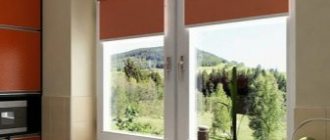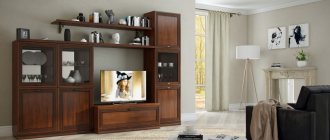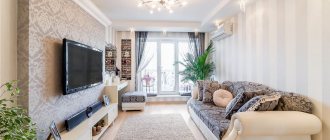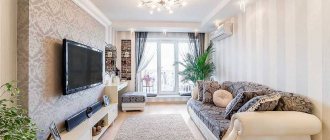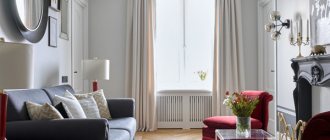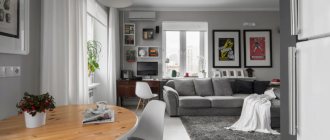The tone of the walls or floors in the interior of a home can be completely arbitrary. After all, this question entirely depends on the personal preferences of the apartment owners. Some people want to see pink walls and dark red floors in their home, while others prefer a more restrained design in cool colors. Considering this point of view, it should be noted that the floor in the interior of the apartment may well be dark. This option looks luxurious and stylish, as we can see by looking at the photo.
Fashionable solution
Do not think that a floor painted in a dark tone is anything unusual. Not at all. Subtle colors of stone or earth are more than natural for floor decoration. Although, looking back at history, it should be noted that light surfaces in the interior have always been considered a sign of wealth and respectability. Today, for example, dark laminate is a completely fashionable and modern solution. One cannot but agree that against the background of a non-staining floor, light-colored furniture looks very impressive, and in any room. But, despite the visual appeal, floors made in dark colors have both advantages and disadvantages.
Vote "Against"
It may be uncomfortable
Light shades do not always work for the benefit of the interior. By choosing white finishes for walls, floors and ceilings, you can lock yourself inside an “egg shell”.
Combine different light shades. Designers recommend abandoning the all-white Scandinavian space in favor of complex, dusty tones.
Be careful with cold colors; if you use them too extensively, the interior may “freeze” and turn out to be uncomfortable, too sterile. Even if a lot of sunlight enters the room, it will not warm the white floor, but on the contrary, it will make it dazzlingly bright, like the first snow.
Be careful with the sun
The sun is the enemy of a white floor; when exposed to direct sunlight, it can turn unsightly yellow and undo its dramatic effect. Usually the problem is solved with varnish. But think about whether a large-scale light surface is needed in an already bright room?
Carpet in the interior: a dust collector or a practical solution?
Carpet invites you to walk barefoot, warms the interior visually and literally, absorbs noise well, and makes any room more comfortable.
But for some it evokes associations with the floor in the office. And some even classify such a coating as a dust collector. Let's talk about the pros and cons of carpet in the interior. There are practically no contraindications for light-colored floors in the interior. Especially if it is a natural material that looks good in any shade. The decision is yours, and any floor coverings in the Lanskoy shopping center.
#How to choose #Review
Disadvantages of a dark floor
The ability to amazingly reduce a room, both in length, width and height. That is why designers do not recommend using black, brown and chocolate tones in small apartments when decorating the floor in the bedroom and living room. A dark background is an excellent indicator of cleanliness in the premises. On such a surface all the crumbs of debris, footprints, and traces of poor cleaning are visible.
Dark laminate does not like scratches and dents from furniture legs. Therefore, in high-traffic areas and under the legs of chairs, armchairs and sofas, you need to place a carpet that will protect the floor.
Vote "For"
Aesthetically
An interior with a light floor looks airier, lighter, brighter. This solution works well in small apartments, visually expanding the space, and in rooms with windows facing north.
Which laminate is better to choose for a children's room?
A child’s own room is his little world. It should be beautiful, cozy, comfortable and safe. Often, when choosing a floor finish, they choose laminate flooring. Which laminate is better to choose for a children's room? Let's figure it out.
Natural shades of light wood always look good as they warm up the space. Imitation of white oak and exotic wood looks expensive, and, if we are talking about tiles or porcelain stoneware, imitation marble. The neutral base will be light gray tones. The boldest, but also the most effective solution is a white floor.
A light shade of flooring is a must-have for minimalist Scandinavian, Provence, Parisian chic, eco and shabby interiors. The light color of the floor in the interior is also appropriate in classical styles, if we are talking about noble parquet.
Don’t be afraid to combine this type of finish with dark furniture or bright pops of color—contrasts make the interior expressive. In addition, a light finish will visually lighten the “cluttering” effect of massive dark furniture and become a blank canvas for interior accents. Many interior styles are built on this principle.
And practical
Contrary to popular myth, light-colored floors are even more unpretentious in everyday life than dark ones. Dust and scratches on them will be less noticeable. Crumbs, debris and muddy shoe marks are another matter. But let’s not talk seriously about which floors are less noticeable when it comes to dirt. And so it’s clear: clean.
Positive traits
The non-staining color floor creates a feeling of stylishness, respectability and solidity. Therefore, to create an original, but at the same time elegant interior in the living room, it is necessary to use a game of contrasts. For example, against a dark laminate background, you can place a sand-colored carpet and complement the picture with light furniture. We see one of the design options in the photo.
Experts are sure that a dark floor in the kitchen or bedroom is associated with reliability and confidence, since such a covering is very reminiscent of a strong earth. But so that the interior of the home does not look gloomy, the tone of the floor cannot be black, but rather chocolate or wood tones.
Types of flooring
Almost every type of finishing material that can be used for decoration is produced in a rich variety of colors. That is why choosing the right material is quite simple. But in most options, preference is given to wooden coverings:
Darkened beech and oak parquet. Parquet flooring is made of wenge or other types of dark wood that are naturally so. Dark laminate that imitates the above-mentioned wood samples.
Of course, natural material is quite luxurious, although impressive. For budget design options, we can recommend porcelain stoneware or dark-colored tiles that imitate natural stone or marble. The photo shows a floor finished with black artificial marble. But it is important to know that finishing with artificial materials creates the feeling that this is not a living space, but a museum hall.
You should not use chocolate and black tones in carpeting. The worst option is a fleecy surface, dark brown or black in color, which gives the room a sloppy look.
How to create a beautiful interior
The most advantageous option is to decorate the kitchen walls in light colors and the floor in dark colors, in combination with light furniture, which can be made in milky, beige, soft creamy tones. By the way, in the living room you can add a few more accessories in light green or turquoise colors, which will add a special zest to the room.
For those who want to paint their home with bright, rich colors, they can use combinations of blue, emerald, gold and lilac shades against the background of a non-staining coating. This design is quite suitable for bedrooms and living rooms. However, in order not to overdo it with color schemes, you should remember that textile accessories should be the same tone as the furniture upholstery or flooring. Provided that the furniture is selected in shades lighter than the floor.
Another design option is a chocolate floor, and one of the walls is a bright, rich color, shown in the photo. This design move allows you to expand a small bedroom or living room. If the room is spacious, then the accent wall can be decorated not with a single color, but with a bright picture. At the same time, the remaining walls are painted in neutral tones, and the interior always uses a couple of dark-colored details.
To summarize, it must be said that dark floors are a sign of luxury and elegance. However, with the correct placement of accents and moderate use of dark shades in the design, even budget housing can look chic. And if you add window and door openings in the same tone to the floors in a non-marking color, then you can safely talk about a successful renovation.
How to combine floor, walls and ceiling in an interior
Most interior design advice is aimed at the “greenfield renovator.” Or those who are ready to clear the old world to the ground and build a marvelous new one in its place. But what if you’re just tired of the old wallpaper and you’re trying to figure out whether the next “color of the year” will suit the existing decor of your home? We tell you how to evaluate the “compatibility” of the main planes in the interior.
If you don't know where to start, start with the floor. Because if you already have a “dream wallpaper”, then for the sake of it you will probably redo your entire environment. And if you just need to update the interior with minimal losses, you should focus on the flooring. After all, it is changed least often, while the ceiling or walls are easy to repaint.
1.If the floor is dark Many people are concerned about the question: if the floor is dark, what kind of walls should there be? Don't be afraid of "active walls". On the contrary, appreciate how lucky you are with a dark floor: you can simultaneously experiment with bright rich shades and expressive prints.
Fact: Dark tones of the flooring are perfectly combined with the active color (pattern) of the walls and light ceiling. However, this combination looks quite catchy, so it is better to choose the main (cabinet) furniture in light colors for the room.
Low or high room is not so important. An option with a dark floor and richly colored walls is suitable for both high and low ceiling rooms. If you want to visually lift a room, go darker with a rich tone or use wallpaper with a vertical pattern.
2. If the floor is dark in a narrow room, apply the principle of an accent wall and under no circumstances change the appearance of the floor, let it remain dark. And feel free to make the walls deep and rich in color, and the ceiling white.
If at the same time you need to visually “correct” a narrow room with a low ceiling or, conversely, correct a high room-well, it is enough to add a light color to one of the “short” (in case of expansion) or “long” (in case of decrease) walls to the previously described scheme . This solution will optically correct the configuration of the room
3. If the floor is dark and you don’t like bright walls. If you like a more measured and traditional palette, but bright shades are not for you, choose the “gradient” effect that is relevant today. Do not confuse with “degrade” (when there is a transition from dark to light on one wall). By gradient I mean the same shade of varying degrees of pigment saturation, which moves from wall to wall and then to the ceiling: say, the ceiling has 5% saturation, one of the walls has 60%, the other has 75%.
The dark floor will be complemented by walls of darker and medium tones and a light ceiling. In this case, one color scheme is used, only the shades will be different. Interestingly, this technique is suitable not only for paint or wallpaper, but also for curtains - “large” surfaces covering walls. Or just for part of the wall.
Important: This combination is suitable for any type of room. The main thing is to correctly distribute the color load across all horizontal and vertical planes.
Dark floor and light walls in the interior
5. If the floor is dark and you want to experiment, try making a dark ceiling - not darker than the floor, of course, but with a clearly defined tonality.
Interestingly, this combination is suitable for rooms with both high and low ceilings. If you are not afraid of non-standard solutions, choose one of two options. Dark floor, light walls (photo above) and dark ceiling - this combination looks very modern.
6. If the floor is light, you can work on the principle of “developing opposites”: make the walls dark and contrasting. They will look even more active due to the light floor and ceiling. By the way, the combination of dark walls and light floors makes the room more elegant.
7. Light interior and light floor Perhaps the most familiar combination from our selection. Light floor, light walls and light ceiling.
To prevent the interior from seeming monotonous, you can choose an original pattern for the walls or a bright and unusual color of furniture that will attract attention.
8. Light floor and dark ceiling A light floor can be perfectly combined with a dark ceiling and with dark and light walls.
This option is suitable for rooms with high ceilings. One or two dark walls (for example, you can match graphite or dark chocolate wallpaper to a light floor) will help add harmony and integrity to the composition. Tip: Do not use too obvious a contrast for this option, so that the planes of the room are not strictly divided in half.
1. A colorful floor or a bright carpet Taking a bright and colorful floor as a basis, complement it with light walls and a light ceiling. Add some bright accents to the decor, leaving the main light palette - this solution will help balance the main accent of the floor.
A bright motley floor, a dark ceiling and light walls is a combination for those who are looking for the brightest and most unusual in the interior: such a palette will not let you get bored. A bright pattern in this case can also be present in textiles. But it’s better to leave the walls plain.
